The Importance of Innovation and Entrepreneurship for Textile Business
VerifiedAdded on 2020/03/07
|8
|2096
|419
Report
AI Summary
This report delves into the crucial interplay of innovation and entrepreneurship within the dynamic textile industry. It begins by defining these interconnected concepts, emphasizing innovation's role as a key driver of competitiveness and entrepreneurship as the process of identifying and capitalizing on opportunities. The report highlights the significance of these factors for business success, illustrated by examples of innovative leaders and their impact. It then explores the application and impact of innovation and entrepreneurship in the textile sector, detailing how businesses can leverage these factors to enhance customer base, revenue, and competitive advantage. The report discusses the importance of technology and disruptive innovation, including the adoption of nanotechnology and the implementation of new business models. It emphasizes the need for creative management, effective leadership, and risk management to foster innovation within textile businesses. The conclusion underscores the necessity of sophisticated management systems and a high degree of innovation and creativity for businesses to thrive in the textile and fashion industry.
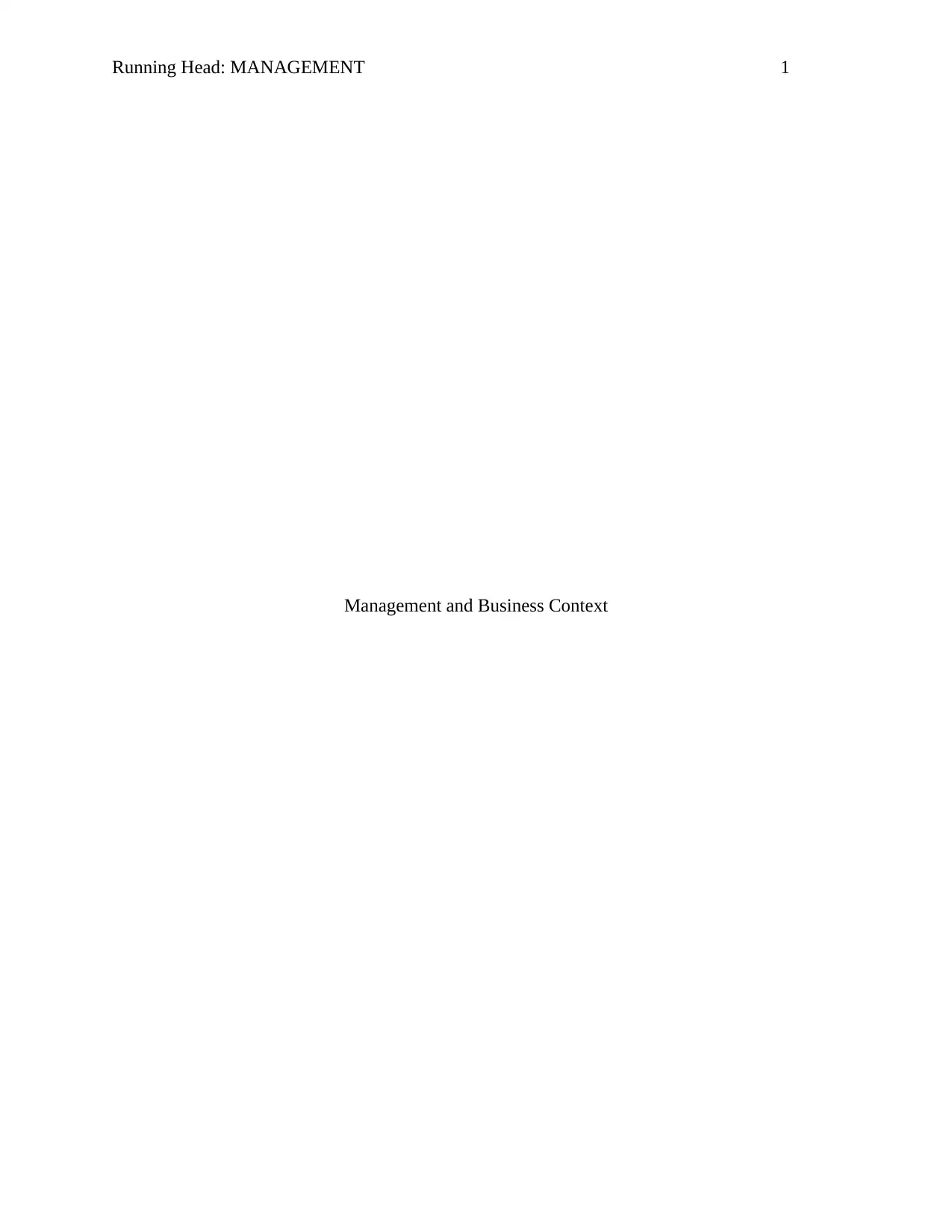
Running Head: MANAGEMENT 1
Management and Business Context
Management and Business Context
Paraphrase This Document
Need a fresh take? Get an instant paraphrase of this document with our AI Paraphraser
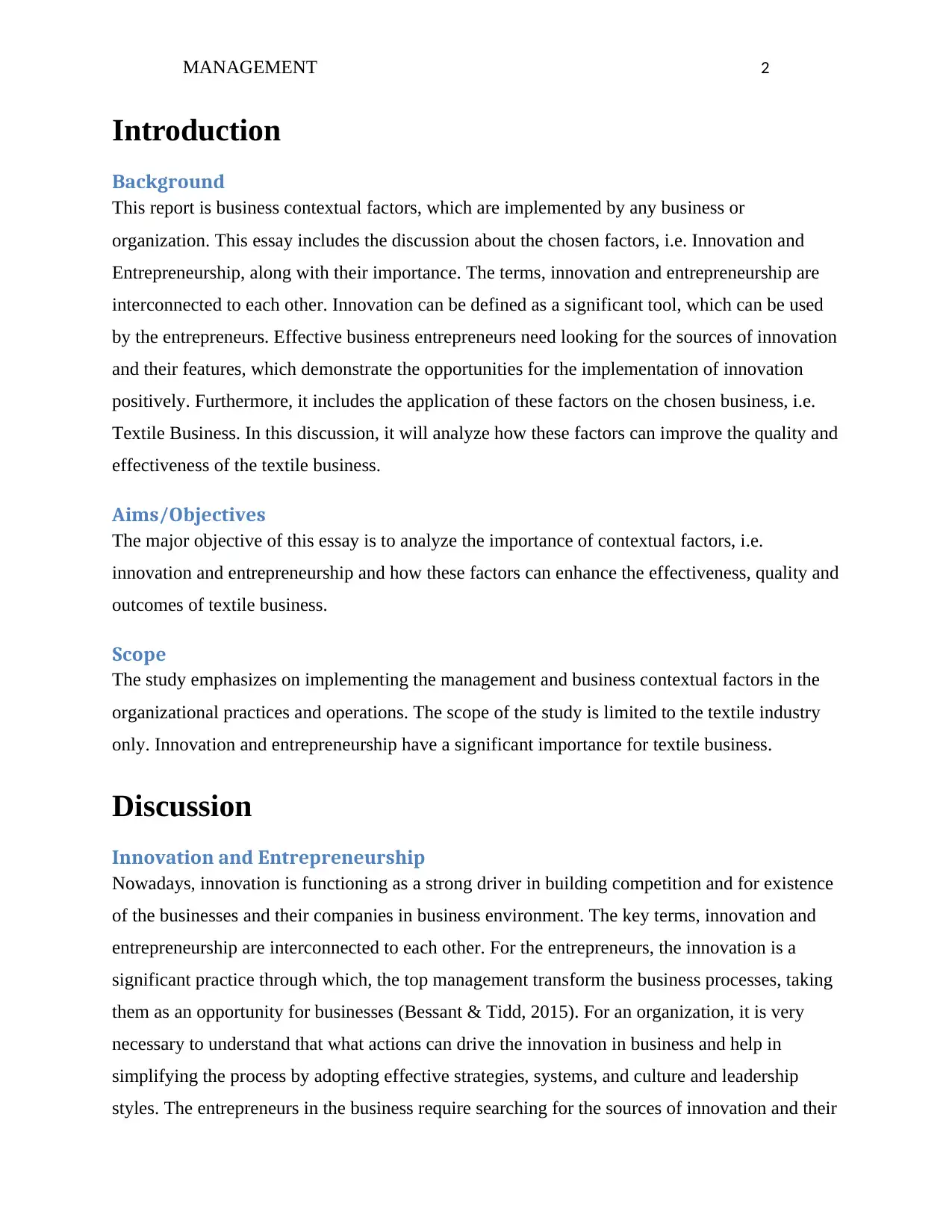
MANAGEMENT 2
Introduction
Background
This report is business contextual factors, which are implemented by any business or
organization. This essay includes the discussion about the chosen factors, i.e. Innovation and
Entrepreneurship, along with their importance. The terms, innovation and entrepreneurship are
interconnected to each other. Innovation can be defined as a significant tool, which can be used
by the entrepreneurs. Effective business entrepreneurs need looking for the sources of innovation
and their features, which demonstrate the opportunities for the implementation of innovation
positively. Furthermore, it includes the application of these factors on the chosen business, i.e.
Textile Business. In this discussion, it will analyze how these factors can improve the quality and
effectiveness of the textile business.
Aims/Objectives
The major objective of this essay is to analyze the importance of contextual factors, i.e.
innovation and entrepreneurship and how these factors can enhance the effectiveness, quality and
outcomes of textile business.
Scope
The study emphasizes on implementing the management and business contextual factors in the
organizational practices and operations. The scope of the study is limited to the textile industry
only. Innovation and entrepreneurship have a significant importance for textile business.
Discussion
Innovation and Entrepreneurship
Nowadays, innovation is functioning as a strong driver in building competition and for existence
of the businesses and their companies in business environment. The key terms, innovation and
entrepreneurship are interconnected to each other. For the entrepreneurs, the innovation is a
significant practice through which, the top management transform the business processes, taking
them as an opportunity for businesses (Bessant & Tidd, 2015). For an organization, it is very
necessary to understand that what actions can drive the innovation in business and help in
simplifying the process by adopting effective strategies, systems, and culture and leadership
styles. The entrepreneurs in the business require searching for the sources of innovation and their
Introduction
Background
This report is business contextual factors, which are implemented by any business or
organization. This essay includes the discussion about the chosen factors, i.e. Innovation and
Entrepreneurship, along with their importance. The terms, innovation and entrepreneurship are
interconnected to each other. Innovation can be defined as a significant tool, which can be used
by the entrepreneurs. Effective business entrepreneurs need looking for the sources of innovation
and their features, which demonstrate the opportunities for the implementation of innovation
positively. Furthermore, it includes the application of these factors on the chosen business, i.e.
Textile Business. In this discussion, it will analyze how these factors can improve the quality and
effectiveness of the textile business.
Aims/Objectives
The major objective of this essay is to analyze the importance of contextual factors, i.e.
innovation and entrepreneurship and how these factors can enhance the effectiveness, quality and
outcomes of textile business.
Scope
The study emphasizes on implementing the management and business contextual factors in the
organizational practices and operations. The scope of the study is limited to the textile industry
only. Innovation and entrepreneurship have a significant importance for textile business.
Discussion
Innovation and Entrepreneurship
Nowadays, innovation is functioning as a strong driver in building competition and for existence
of the businesses and their companies in business environment. The key terms, innovation and
entrepreneurship are interconnected to each other. For the entrepreneurs, the innovation is a
significant practice through which, the top management transform the business processes, taking
them as an opportunity for businesses (Bessant & Tidd, 2015). For an organization, it is very
necessary to understand that what actions can drive the innovation in business and help in
simplifying the process by adopting effective strategies, systems, and culture and leadership
styles. The entrepreneurs in the business require searching for the sources of innovation and their
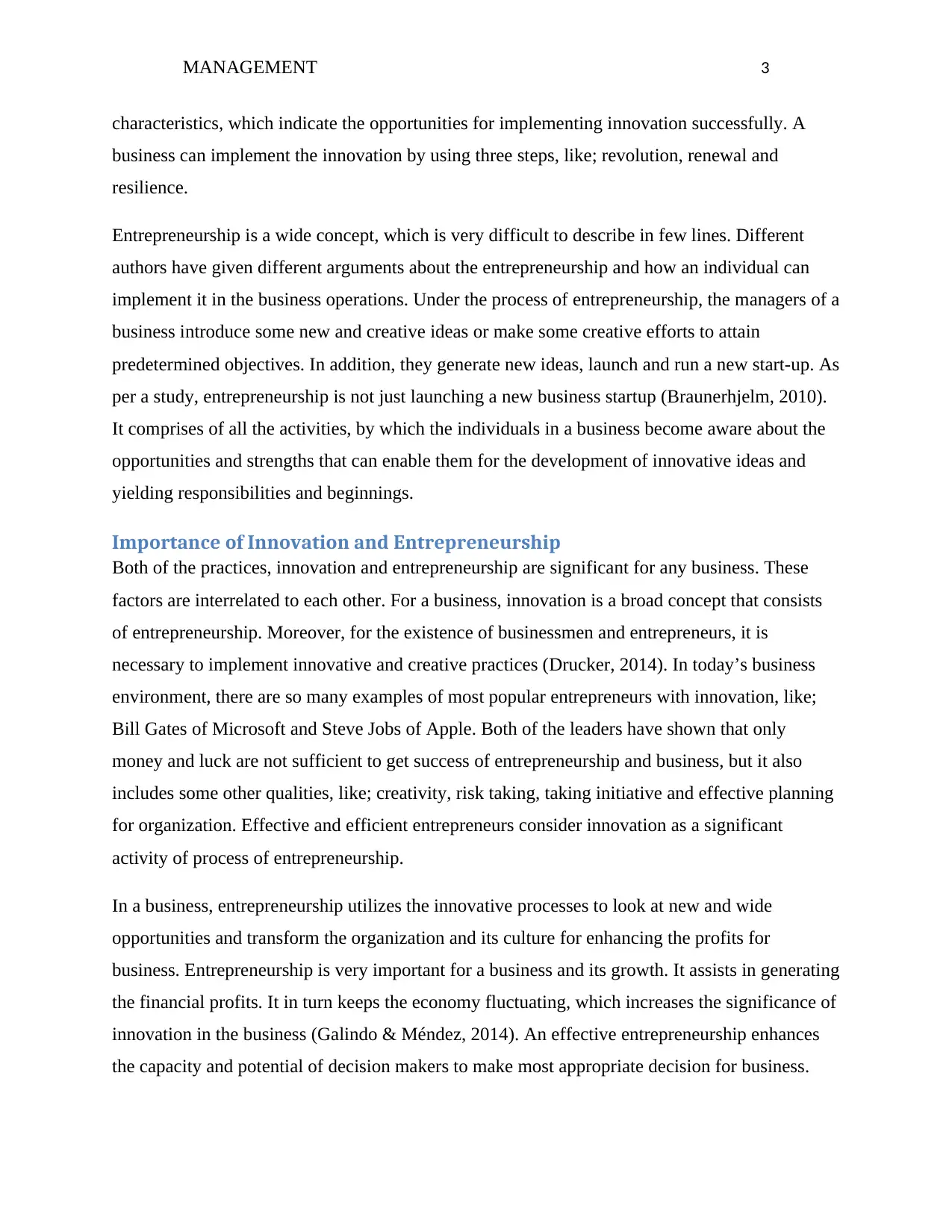
MANAGEMENT 3
characteristics, which indicate the opportunities for implementing innovation successfully. A
business can implement the innovation by using three steps, like; revolution, renewal and
resilience.
Entrepreneurship is a wide concept, which is very difficult to describe in few lines. Different
authors have given different arguments about the entrepreneurship and how an individual can
implement it in the business operations. Under the process of entrepreneurship, the managers of a
business introduce some new and creative ideas or make some creative efforts to attain
predetermined objectives. In addition, they generate new ideas, launch and run a new start-up. As
per a study, entrepreneurship is not just launching a new business startup (Braunerhjelm, 2010).
It comprises of all the activities, by which the individuals in a business become aware about the
opportunities and strengths that can enable them for the development of innovative ideas and
yielding responsibilities and beginnings.
Importance of Innovation and Entrepreneurship
Both of the practices, innovation and entrepreneurship are significant for any business. These
factors are interrelated to each other. For a business, innovation is a broad concept that consists
of entrepreneurship. Moreover, for the existence of businessmen and entrepreneurs, it is
necessary to implement innovative and creative practices (Drucker, 2014). In today’s business
environment, there are so many examples of most popular entrepreneurs with innovation, like;
Bill Gates of Microsoft and Steve Jobs of Apple. Both of the leaders have shown that only
money and luck are not sufficient to get success of entrepreneurship and business, but it also
includes some other qualities, like; creativity, risk taking, taking initiative and effective planning
for organization. Effective and efficient entrepreneurs consider innovation as a significant
activity of process of entrepreneurship.
In a business, entrepreneurship utilizes the innovative processes to look at new and wide
opportunities and transform the organization and its culture for enhancing the profits for
business. Entrepreneurship is very important for a business and its growth. It assists in generating
the financial profits. It in turn keeps the economy fluctuating, which increases the significance of
innovation in the business (Galindo & Méndez, 2014). An effective entrepreneurship enhances
the capacity and potential of decision makers to make most appropriate decision for business.
characteristics, which indicate the opportunities for implementing innovation successfully. A
business can implement the innovation by using three steps, like; revolution, renewal and
resilience.
Entrepreneurship is a wide concept, which is very difficult to describe in few lines. Different
authors have given different arguments about the entrepreneurship and how an individual can
implement it in the business operations. Under the process of entrepreneurship, the managers of a
business introduce some new and creative ideas or make some creative efforts to attain
predetermined objectives. In addition, they generate new ideas, launch and run a new start-up. As
per a study, entrepreneurship is not just launching a new business startup (Braunerhjelm, 2010).
It comprises of all the activities, by which the individuals in a business become aware about the
opportunities and strengths that can enable them for the development of innovative ideas and
yielding responsibilities and beginnings.
Importance of Innovation and Entrepreneurship
Both of the practices, innovation and entrepreneurship are significant for any business. These
factors are interrelated to each other. For a business, innovation is a broad concept that consists
of entrepreneurship. Moreover, for the existence of businessmen and entrepreneurs, it is
necessary to implement innovative and creative practices (Drucker, 2014). In today’s business
environment, there are so many examples of most popular entrepreneurs with innovation, like;
Bill Gates of Microsoft and Steve Jobs of Apple. Both of the leaders have shown that only
money and luck are not sufficient to get success of entrepreneurship and business, but it also
includes some other qualities, like; creativity, risk taking, taking initiative and effective planning
for organization. Effective and efficient entrepreneurs consider innovation as a significant
activity of process of entrepreneurship.
In a business, entrepreneurship utilizes the innovative processes to look at new and wide
opportunities and transform the organization and its culture for enhancing the profits for
business. Entrepreneurship is very important for a business and its growth. It assists in generating
the financial profits. It in turn keeps the economy fluctuating, which increases the significance of
innovation in the business (Galindo & Méndez, 2014). An effective entrepreneurship enhances
the capacity and potential of decision makers to make most appropriate decision for business.
⊘ This is a preview!⊘
Do you want full access?
Subscribe today to unlock all pages.

Trusted by 1+ million students worldwide
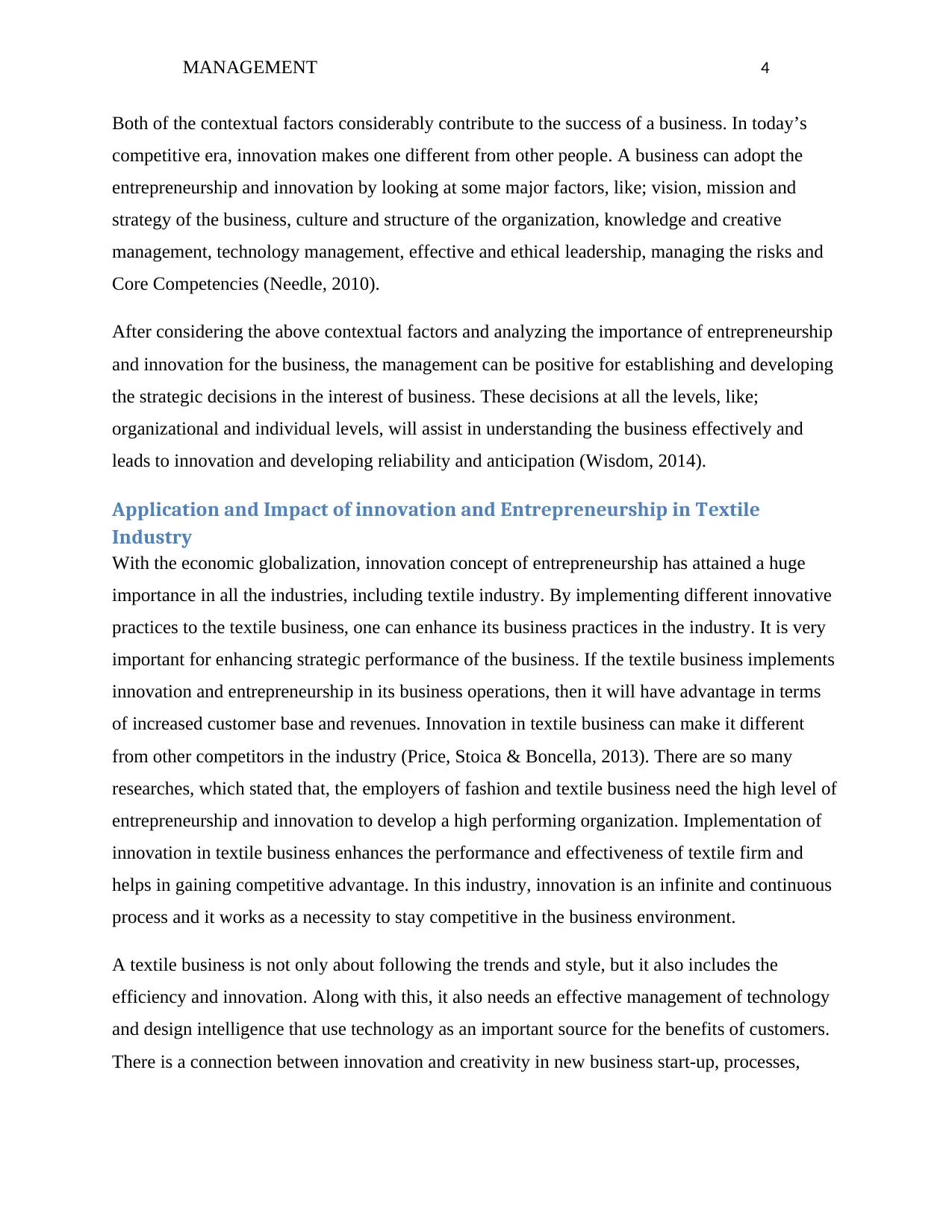
MANAGEMENT 4
Both of the contextual factors considerably contribute to the success of a business. In today’s
competitive era, innovation makes one different from other people. A business can adopt the
entrepreneurship and innovation by looking at some major factors, like; vision, mission and
strategy of the business, culture and structure of the organization, knowledge and creative
management, technology management, effective and ethical leadership, managing the risks and
Core Competencies (Needle, 2010).
After considering the above contextual factors and analyzing the importance of entrepreneurship
and innovation for the business, the management can be positive for establishing and developing
the strategic decisions in the interest of business. These decisions at all the levels, like;
organizational and individual levels, will assist in understanding the business effectively and
leads to innovation and developing reliability and anticipation (Wisdom, 2014).
Application and Impact of innovation and Entrepreneurship in Textile
Industry
With the economic globalization, innovation concept of entrepreneurship has attained a huge
importance in all the industries, including textile industry. By implementing different innovative
practices to the textile business, one can enhance its business practices in the industry. It is very
important for enhancing strategic performance of the business. If the textile business implements
innovation and entrepreneurship in its business operations, then it will have advantage in terms
of increased customer base and revenues. Innovation in textile business can make it different
from other competitors in the industry (Price, Stoica & Boncella, 2013). There are so many
researches, which stated that, the employers of fashion and textile business need the high level of
entrepreneurship and innovation to develop a high performing organization. Implementation of
innovation in textile business enhances the performance and effectiveness of textile firm and
helps in gaining competitive advantage. In this industry, innovation is an infinite and continuous
process and it works as a necessity to stay competitive in the business environment.
A textile business is not only about following the trends and style, but it also includes the
efficiency and innovation. Along with this, it also needs an effective management of technology
and design intelligence that use technology as an important source for the benefits of customers.
There is a connection between innovation and creativity in new business start-up, processes,
Both of the contextual factors considerably contribute to the success of a business. In today’s
competitive era, innovation makes one different from other people. A business can adopt the
entrepreneurship and innovation by looking at some major factors, like; vision, mission and
strategy of the business, culture and structure of the organization, knowledge and creative
management, technology management, effective and ethical leadership, managing the risks and
Core Competencies (Needle, 2010).
After considering the above contextual factors and analyzing the importance of entrepreneurship
and innovation for the business, the management can be positive for establishing and developing
the strategic decisions in the interest of business. These decisions at all the levels, like;
organizational and individual levels, will assist in understanding the business effectively and
leads to innovation and developing reliability and anticipation (Wisdom, 2014).
Application and Impact of innovation and Entrepreneurship in Textile
Industry
With the economic globalization, innovation concept of entrepreneurship has attained a huge
importance in all the industries, including textile industry. By implementing different innovative
practices to the textile business, one can enhance its business practices in the industry. It is very
important for enhancing strategic performance of the business. If the textile business implements
innovation and entrepreneurship in its business operations, then it will have advantage in terms
of increased customer base and revenues. Innovation in textile business can make it different
from other competitors in the industry (Price, Stoica & Boncella, 2013). There are so many
researches, which stated that, the employers of fashion and textile business need the high level of
entrepreneurship and innovation to develop a high performing organization. Implementation of
innovation in textile business enhances the performance and effectiveness of textile firm and
helps in gaining competitive advantage. In this industry, innovation is an infinite and continuous
process and it works as a necessity to stay competitive in the business environment.
A textile business is not only about following the trends and style, but it also includes the
efficiency and innovation. Along with this, it also needs an effective management of technology
and design intelligence that use technology as an important source for the benefits of customers.
There is a connection between innovation and creativity in new business start-up, processes,
Paraphrase This Document
Need a fresh take? Get an instant paraphrase of this document with our AI Paraphraser
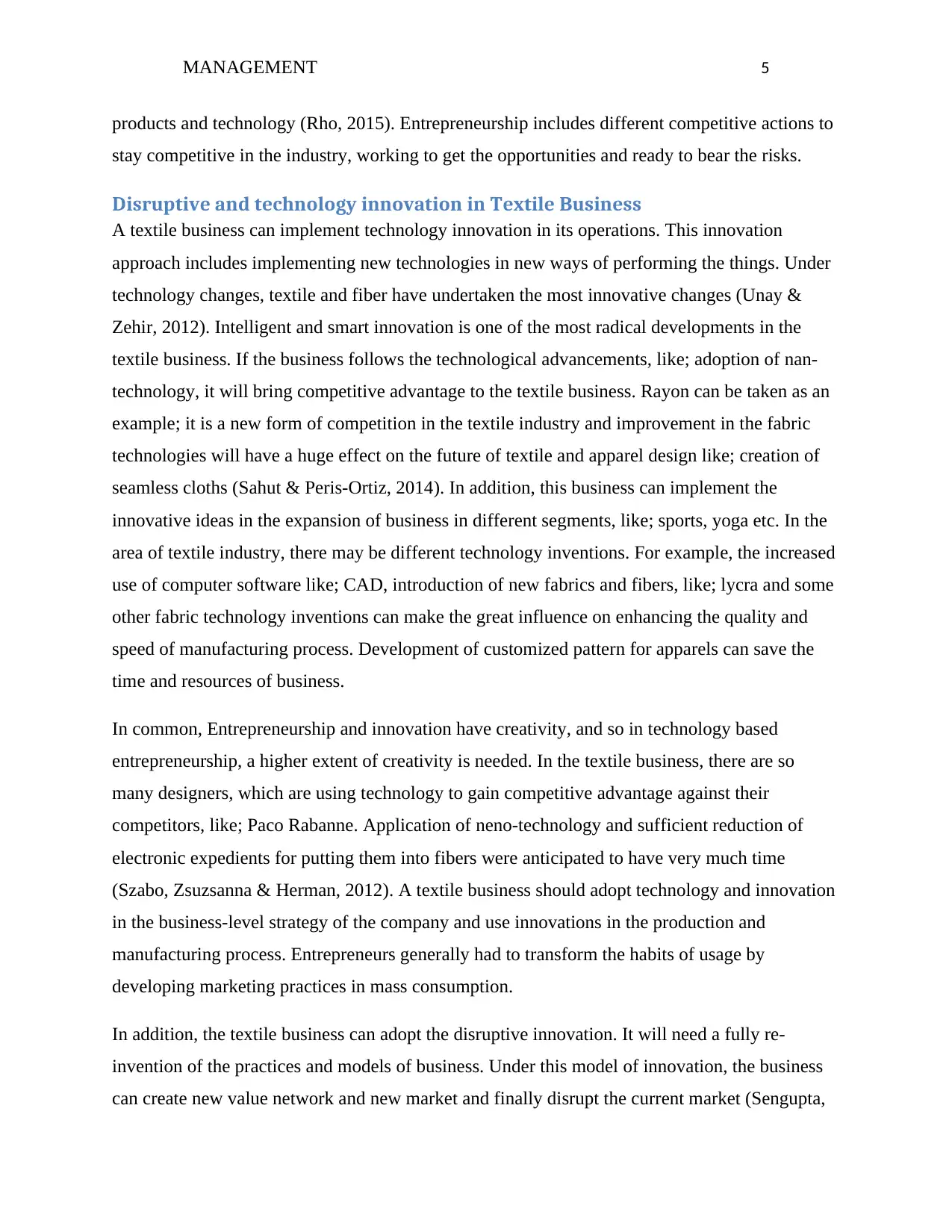
MANAGEMENT 5
products and technology (Rho, 2015). Entrepreneurship includes different competitive actions to
stay competitive in the industry, working to get the opportunities and ready to bear the risks.
Disruptive and technology innovation in Textile Business
A textile business can implement technology innovation in its operations. This innovation
approach includes implementing new technologies in new ways of performing the things. Under
technology changes, textile and fiber have undertaken the most innovative changes (Unay &
Zehir, 2012). Intelligent and smart innovation is one of the most radical developments in the
textile business. If the business follows the technological advancements, like; adoption of nan-
technology, it will bring competitive advantage to the textile business. Rayon can be taken as an
example; it is a new form of competition in the textile industry and improvement in the fabric
technologies will have a huge effect on the future of textile and apparel design like; creation of
seamless cloths (Sahut & Peris-Ortiz, 2014). In addition, this business can implement the
innovative ideas in the expansion of business in different segments, like; sports, yoga etc. In the
area of textile industry, there may be different technology inventions. For example, the increased
use of computer software like; CAD, introduction of new fabrics and fibers, like; lycra and some
other fabric technology inventions can make the great influence on enhancing the quality and
speed of manufacturing process. Development of customized pattern for apparels can save the
time and resources of business.
In common, Entrepreneurship and innovation have creativity, and so in technology based
entrepreneurship, a higher extent of creativity is needed. In the textile business, there are so
many designers, which are using technology to gain competitive advantage against their
competitors, like; Paco Rabanne. Application of neno-technology and sufficient reduction of
electronic expedients for putting them into fibers were anticipated to have very much time
(Szabo, Zsuzsanna & Herman, 2012). A textile business should adopt technology and innovation
in the business-level strategy of the company and use innovations in the production and
manufacturing process. Entrepreneurs generally had to transform the habits of usage by
developing marketing practices in mass consumption.
In addition, the textile business can adopt the disruptive innovation. It will need a fully re-
invention of the practices and models of business. Under this model of innovation, the business
can create new value network and new market and finally disrupt the current market (Sengupta,
products and technology (Rho, 2015). Entrepreneurship includes different competitive actions to
stay competitive in the industry, working to get the opportunities and ready to bear the risks.
Disruptive and technology innovation in Textile Business
A textile business can implement technology innovation in its operations. This innovation
approach includes implementing new technologies in new ways of performing the things. Under
technology changes, textile and fiber have undertaken the most innovative changes (Unay &
Zehir, 2012). Intelligent and smart innovation is one of the most radical developments in the
textile business. If the business follows the technological advancements, like; adoption of nan-
technology, it will bring competitive advantage to the textile business. Rayon can be taken as an
example; it is a new form of competition in the textile industry and improvement in the fabric
technologies will have a huge effect on the future of textile and apparel design like; creation of
seamless cloths (Sahut & Peris-Ortiz, 2014). In addition, this business can implement the
innovative ideas in the expansion of business in different segments, like; sports, yoga etc. In the
area of textile industry, there may be different technology inventions. For example, the increased
use of computer software like; CAD, introduction of new fabrics and fibers, like; lycra and some
other fabric technology inventions can make the great influence on enhancing the quality and
speed of manufacturing process. Development of customized pattern for apparels can save the
time and resources of business.
In common, Entrepreneurship and innovation have creativity, and so in technology based
entrepreneurship, a higher extent of creativity is needed. In the textile business, there are so
many designers, which are using technology to gain competitive advantage against their
competitors, like; Paco Rabanne. Application of neno-technology and sufficient reduction of
electronic expedients for putting them into fibers were anticipated to have very much time
(Szabo, Zsuzsanna & Herman, 2012). A textile business should adopt technology and innovation
in the business-level strategy of the company and use innovations in the production and
manufacturing process. Entrepreneurs generally had to transform the habits of usage by
developing marketing practices in mass consumption.
In addition, the textile business can adopt the disruptive innovation. It will need a fully re-
invention of the practices and models of business. Under this model of innovation, the business
can create new value network and new market and finally disrupt the current market (Sengupta,
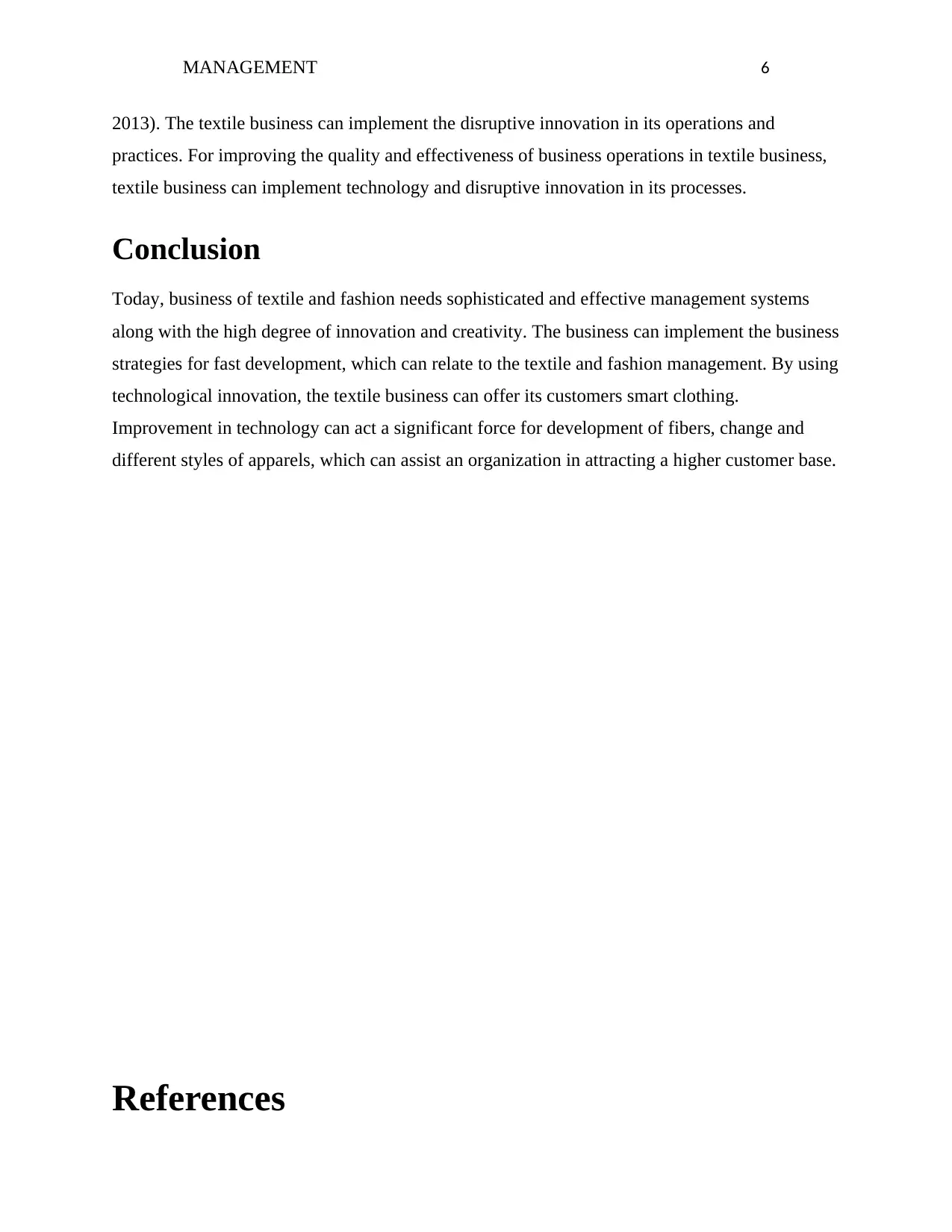
MANAGEMENT 6
2013). The textile business can implement the disruptive innovation in its operations and
practices. For improving the quality and effectiveness of business operations in textile business,
textile business can implement technology and disruptive innovation in its processes.
Conclusion
Today, business of textile and fashion needs sophisticated and effective management systems
along with the high degree of innovation and creativity. The business can implement the business
strategies for fast development, which can relate to the textile and fashion management. By using
technological innovation, the textile business can offer its customers smart clothing.
Improvement in technology can act a significant force for development of fibers, change and
different styles of apparels, which can assist an organization in attracting a higher customer base.
References
2013). The textile business can implement the disruptive innovation in its operations and
practices. For improving the quality and effectiveness of business operations in textile business,
textile business can implement technology and disruptive innovation in its processes.
Conclusion
Today, business of textile and fashion needs sophisticated and effective management systems
along with the high degree of innovation and creativity. The business can implement the business
strategies for fast development, which can relate to the textile and fashion management. By using
technological innovation, the textile business can offer its customers smart clothing.
Improvement in technology can act a significant force for development of fibers, change and
different styles of apparels, which can assist an organization in attracting a higher customer base.
References
⊘ This is a preview!⊘
Do you want full access?
Subscribe today to unlock all pages.

Trusted by 1+ million students worldwide
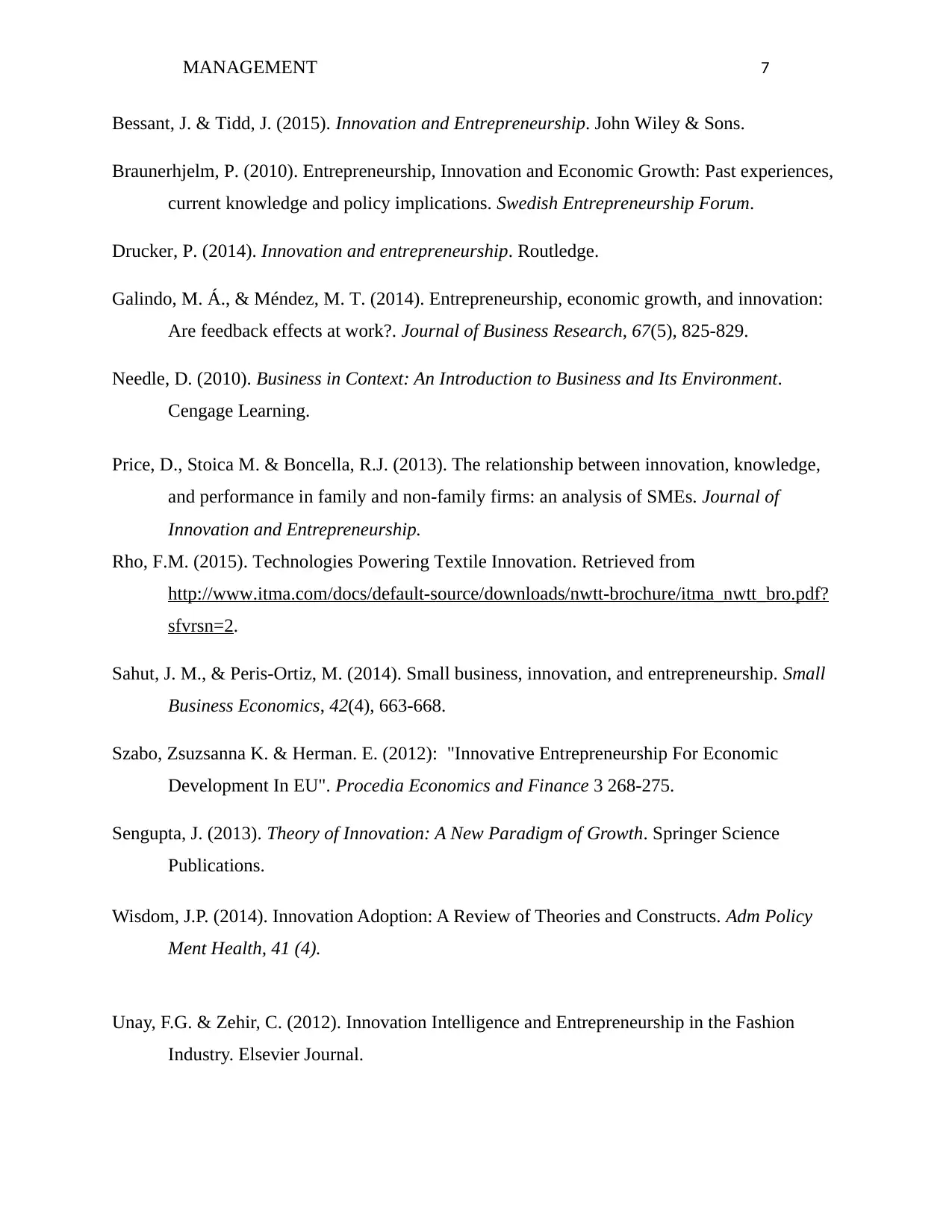
MANAGEMENT 7
Bessant, J. & Tidd, J. (2015). Innovation and Entrepreneurship. John Wiley & Sons.
Braunerhjelm, P. (2010). Entrepreneurship, Innovation and Economic Growth: Past experiences,
current knowledge and policy implications. Swedish Entrepreneurship Forum.
Drucker, P. (2014). Innovation and entrepreneurship. Routledge.
Galindo, M. Á., & Méndez, M. T. (2014). Entrepreneurship, economic growth, and innovation:
Are feedback effects at work?. Journal of Business Research, 67(5), 825-829.
Needle, D. (2010). Business in Context: An Introduction to Business and Its Environment.
Cengage Learning.
Price, D., Stoica M. & Boncella, R.J. (2013). The relationship between innovation, knowledge,
and performance in family and non-family firms: an analysis of SMEs. Journal of
Innovation and Entrepreneurship.
Rho, F.M. (2015). Technologies Powering Textile Innovation. Retrieved from
http://www.itma.com/docs/default-source/downloads/nwtt-brochure/itma_nwtt_bro.pdf?
sfvrsn=2.
Sahut, J. M., & Peris-Ortiz, M. (2014). Small business, innovation, and entrepreneurship. Small
Business Economics, 42(4), 663-668.
Szabo, Zsuzsanna K. & Herman. E. (2012): "Innovative Entrepreneurship For Economic
Development In EU". Procedia Economics and Finance 3 268-275.
Sengupta, J. (2013). Theory of Innovation: A New Paradigm of Growth. Springer Science
Publications.
Wisdom, J.P. (2014). Innovation Adoption: A Review of Theories and Constructs. Adm Policy
Ment Health, 41 (4).
Unay, F.G. & Zehir, C. (2012). Innovation Intelligence and Entrepreneurship in the Fashion
Industry. Elsevier Journal.
Bessant, J. & Tidd, J. (2015). Innovation and Entrepreneurship. John Wiley & Sons.
Braunerhjelm, P. (2010). Entrepreneurship, Innovation and Economic Growth: Past experiences,
current knowledge and policy implications. Swedish Entrepreneurship Forum.
Drucker, P. (2014). Innovation and entrepreneurship. Routledge.
Galindo, M. Á., & Méndez, M. T. (2014). Entrepreneurship, economic growth, and innovation:
Are feedback effects at work?. Journal of Business Research, 67(5), 825-829.
Needle, D. (2010). Business in Context: An Introduction to Business and Its Environment.
Cengage Learning.
Price, D., Stoica M. & Boncella, R.J. (2013). The relationship between innovation, knowledge,
and performance in family and non-family firms: an analysis of SMEs. Journal of
Innovation and Entrepreneurship.
Rho, F.M. (2015). Technologies Powering Textile Innovation. Retrieved from
http://www.itma.com/docs/default-source/downloads/nwtt-brochure/itma_nwtt_bro.pdf?
sfvrsn=2.
Sahut, J. M., & Peris-Ortiz, M. (2014). Small business, innovation, and entrepreneurship. Small
Business Economics, 42(4), 663-668.
Szabo, Zsuzsanna K. & Herman. E. (2012): "Innovative Entrepreneurship For Economic
Development In EU". Procedia Economics and Finance 3 268-275.
Sengupta, J. (2013). Theory of Innovation: A New Paradigm of Growth. Springer Science
Publications.
Wisdom, J.P. (2014). Innovation Adoption: A Review of Theories and Constructs. Adm Policy
Ment Health, 41 (4).
Unay, F.G. & Zehir, C. (2012). Innovation Intelligence and Entrepreneurship in the Fashion
Industry. Elsevier Journal.
Paraphrase This Document
Need a fresh take? Get an instant paraphrase of this document with our AI Paraphraser

MANAGEMENT 8
1 out of 8
Related Documents
Your All-in-One AI-Powered Toolkit for Academic Success.
+13062052269
info@desklib.com
Available 24*7 on WhatsApp / Email
![[object Object]](/_next/static/media/star-bottom.7253800d.svg)
Unlock your academic potential
Copyright © 2020–2025 A2Z Services. All Rights Reserved. Developed and managed by ZUCOL.





